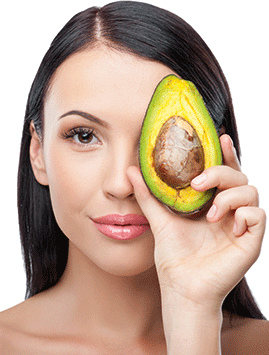Feed your face!

We asked the experts to come up with their favourite foods for skin health and some top tips for how to incorporate them in your diet
It has often been said that what you put into your body is reflected on the outside, which is why a healthy diet is crucial to good skin, particularly as we get older. “Prevention is better than cure when it comes to anti-ageing,” says fitness and nutrition expert Alexandra Wilson (www.alexandrawilson.com). “And to do this effectively we need to address our health both internally and externally. Protecting your skin does not only relate to how you treat it from the outside but how you nourish from the inside too through a healthy lifestyle and wholesome food.” Here are some top foods to eat for radiant skin.
Avocado
“Avocados are packed with high amounts of fibre, plant sterols, magnesium, folate, protein, potassium and vitamins B6, E and K,” explains Frida Harju, in-house nutritionist with health and fitness app, Lifesum (www.lifesum.com). “They also contain biotin, which helps to prevent dry skin and brittle hair and nails, and they are rich in omega-9 fats which repair damaged skin by reducing redness and irritation. Although avocados are high in fat, they contain monounsaturated fat – the good fat that lowers blood cholesterol levels. Avocados are also a rich source of phytosterols such as beta-sitosterol, campesterol and stigmasterol which help to keep inflammation under control.”
TOP TIP For the perfect guacamole mix two avocados with one pressed garlic clove, a quarter of a cup of Turkish yogurt and one tablespoon of lemon juice. Add half a chopped red chili, half a finely chopped yellow onion and one chopped tomato and season with salt and pepper.
Dark leafy greens
“Dark leafy greens contain folate, which contributes to DNA repair, giving your skin a youthful appearance,” explains Irene Arango, co-founder of raw food restaurant Nama in London’s Notting Hill (www.namafoods.com). “They are also a great source of beta carotene, an antioxidant which regenerates skin cells. Spinach is full of bioflavonoids, carotenoids and vitamins A, C and B6. When combined they really help to reduce environmental damage to the skin membrane, preventing the appearance of wrinkles. Green leafy vegetables like kale and spinach are high in lutein and zeaxanthin, two antioxidant molecules which can help to reduce the effects of sun on the skin, therefore reducing premature ageing.”
TOP TIP Use kale or spinach raw in salads or simply add them to your favourite juice or smoothie recipe. Always choose fresh-looking greens and avoid those with brown spots.
Butternut squash
“Butternut squash is packed with a family of pigments called carotenoids,” says nutritionist Sarah Schenker (www.sarahschenker.co.uk). “Beta carotene is the most well-known and abundant of these and is converted by the body into active vitamin A which is required for healthy skin. Studies have shown that eating butternut squash and other beta carotene-rich foods seems to improve skin and may reduce wrinkles and other signs of ageing. Beta carotene acts as an antioxidant and zaps free radicals that cause oxidative damage to cells and increase ageing when we are exposed to pollutants and other environmental hazards like smoking. Beta carotene may also boost the effectiveness of sunscreen. The internal sunscreen protection afforded by this potent pigment is caused by beta-carotene’s ability to quell oxygen damage triggered by UV rays.”
TOP TIP Make a tasty salad by combining baked butternut squash with some rocket, onions, olives, cranberries and pumpkin seeds and sprinkle some lemon juice over the top.

Mackerel
“Mackerel is rich in essential fatty acids (EFAs) which are vital to the health of your skin,” says Hilery Dorrian, homeopath and co-founder of the new SkinGenius range (www.skin-genius.co.uk). “These important nutrients help your cells retain water and flush out toxins, so making sure you include them in your diet can help your skin in a number of ways. They help to counter dryness in the skin so are wonderful if you suffer from problems such as eczema. They help to maintain the water balance of your cells to keep your skin looking plump and hydrated. They play a part in keeping your cell membranes healthy and so may also be useful if you suffer from acne. Other oily fish such as sardines are another great source of EFAs, while walnuts and pumpkin seeds are also rich in this amazing nutrient.”
TOP TIP Coat a mackerel fillet in lemon or lime juice, add some crushed garlic or ginger and grill for five minutes on each side. Sprinkle with fresh parsley and serve with rice and veggies.
Bone broth
2015 has seen the rise of humble broth,” says Alice Mackintosh (www.alicemackintosh.com), nutrition consultant and founder of Equi London nutritional supplements which launch in January. “However, boiling up bones to make broth is nothing new; and be it borscht, stock, Jewish penicillin, consomme, pho or good old chicken soup, almost every culture has their own variation of this nourishing broth. And for good reason. The nutrients that give bones and cartilage their strength and structure are innately good for us too. Being naturally rich in collagen, bone broth is a cheaper way to get a collagen beauty hit and can be made at home. It also has the added benefit of other nutrients such as zinc and calcium which support the skin, and it is also a source of keratin, the major protein in our hair and nails.”
TOP TIP Boiling up a chicken carcass, shells and bones from fish/seafood, or bones from beef or lamb for three hours or more enhances the breakdown and extraction of many nutrients, leaving a nutrient-dense drink that contains easily-absorbable goodness.
Kefir
“Skin issues including eczema, psoriasis, rosacea and acne have now been found to be autoimmune related,” says Shann Jones of Chuckling Goat, suppliers of kefir and kefir skincare (www.chucklinggoat.co.uk). “The most effective way to heal autoimmune issues is to repopulate the gut with the helpful microflora that your body needs. Kefir is a powerful multi-strain probiotic and the most effective way to use it is to drink it for 21 days, to rebuild your microbiome (the genetic material of all the microbes that live on and inside the human body). It can also be applied to the skin in the form of cleansers and lotions that contain kefir, enabling your skin to heal from the inside and the outside.”
TOP TIP Mix the kefir with banana or frozen berries for an all-natural ‘frozen yoghurt’.
Hemp seeds
“Hemp seeds contain a mixture of omega-3 and omega-6 essential fatty acids, which are essential for skin health,” says Melly Lou, naturopath and Farm Doctor at Farm Girl Café (www.thefarmgirl.co.uk). “Hemp seeds and hemp seed oil contain around 60 per cent linoleic acid which is a substance responsible for sebum regulation. If our internal body has a lack of linoleic acid our sebum production is reduced, resulting in the usual free-flowing sebum hardening in the pores and contributing to blackheads and acne. Hemp seeds naturally contain around 10iu per 100g of vitamin D, an essential vitamin in reducing skin inflammation, eczema and psoriasis.”
TOP TIP Try sprinkling some hemp protein powder on scrambled eggs, stir-fried vegetables and salads.
Read previous Your Look articles here...